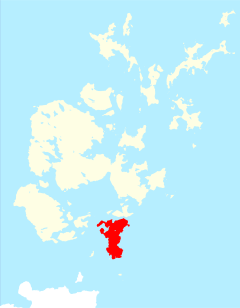South Ronaldsay
| South Ronaldsay | |
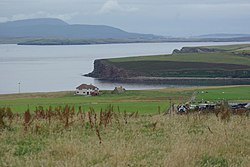 Across South Ronaldsay and over Scapa Flow | |
|---|---|
| Main village: | St Margaret's Hope |
| Location | |
| Grid reference: | ND449899 |
| Area: | 19.2 sq miles |
| Highest point: | Ward Hill; 387 feet |
| Data | |
| Population: | 854 |
South Ronaldsay is one of the islands of Orkney. It is linked to Mainland, Orkney by the Churchill Barriers which carry the road by way of Burray, Glimps Holm and Lamb Holm.
The island's name, like that of almost all the islands, is from Old Norse, in which tongue it was known as Rognvaldsey; Rognvald's island. Which Rognvald this is we do not know; the earliest known in connection with the islands is Rognvald Earl of Møre in Norway, whose son received the Earldom of Orkney, and the most famous in the Earl who reunited the islands and went on an eventful pilgrimage to Jerusalem, though the isle almost certainly had its name by his day. It may be named for a simple farmer. It is unconnected with the name of North Ronaldsay, but has taken "South" to avoid confusion between the two. North Ronaldsay and South Ronaldsay are the northernmost and southernmost of the inhabited islands of Orkney.
Geography and geology
With an area of 19.2 square miles, South Ronaldsay is the fourth largest of the Orkney islands. Ferries sail from Burwick on the island to John o' Groats in Caithness and from St Margaret's Hope to Gills Bay.[1]
South Ronaldsay's main village is St Margaret's Hope, Orkney's third largest settlement. It is believed to be named either after Margaret, Maid of Norway, the heir to the Scottish throne who died in Orkney age seven[2] or possibly after Saint Margaret of Scotland. The village has a small blacksmith's museum and is known for its annual Boys' Ploughing Match. During this event young girls dressed in dark jackets play the part of the horses and young boys using miniature ploughs compete with one another at ploughing furrows in the nearby sands.[1]
The cardinal points of the island are Ayre of Cara, by Churchill Barrier no. 4 (north), Grim Ness (east), Brough Ness, (south) and Hoxa Head, (west). The highest elevation is Ward Hill, which reaches 387 feet. This name is common one in Orkney for the highest point on an island and comes from the historic use of these places used for the lighting of warning beacons.[3]
Prehistory
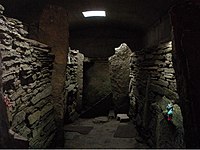
The island is known for the Neolithic Isbister Chambered Cairn, popularly known as the "Tomb of the Eagles". Discovered by Ronald Simison in 1958 in the south east of the island, 16,000 human bones and 725 bird bones were found at the site, the latter predominantly belonging to the White-tailed Sea Eagle (Haliaeetus albicilla). The evidence suggests that the bodies interred had been exposed to the elements to remove the flesh before burial. The tomb was in continuous use for a millennium or more.[4][5]
The burnt mound at nearby Liddle, discovered by Simison in 1972, is the best example of a Bronze Age cooking place in Orkney. Made of flat slabs originally sealed with clay, the central stone trough would have been filled with water heated by stones using peat as a fuel. The building was probably roofless.[6]
There is a broch site at Howe of Hoxa in the north west that may have been the burial place of the Earl Thorfinn "Skullsplitter".[1]
History
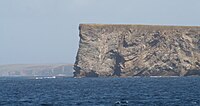
After which of the Rognvalds famous in Orcadian history the island is named is not known, if it is named for any of the known men and earls of that name. The island plays its role in the great tales of the Orkneyinga Saga, in particular whenever warriors or farmers sail to and from that other Norse colony, Caithness. It is believed that Thorfinn Skullsplitter, the earl of Orkney and Earl or Caithness, may lie buried in the Howe of Hoxa on South Ronaldsay.
In 1627 nine chapels were recorded on the island: Sant Androis at Woundwick, Our Ladie at Halcro, Sant Colmis at Loch of Burwick, Ruid chappell in Sandwick, Sant Tola [Olaf] in Wydwall, Sant Colme in Hoxay, Sant Margrat in the Howp, Sant Colmeis in Grymnes and Sant Ninian in Stow. The locations are all known although little physical evidence remains in several cases.[7]
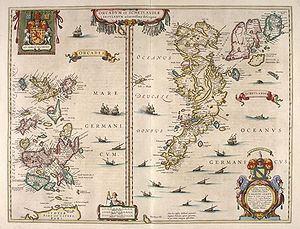
In the late seventeenth century South Ronaldsay was described as "fertile in Corns and abounding with People".[8] Murdoch MacKenzie's 1750 map of the island indicates the site of lead workings near Grimness and a visitor in 1774 "saw several deep holes which I was informed were sunk in search of Lead ore" although only small quantities were mined.[7]
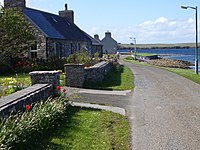
By the late eighteenth century South Ronaldsay was divided into two unequally sized parishes, St Peter's covered the northern two thirds of the island while St. Mary's formed the southern third. St. Peter's church has a date stone of 1642 and appears on Blaeu's 1654 map. By 1793 the building had no roof and was "exposed to all the winds of heaven" but as probably repaired by 1801. A Pictish symbol stone was discovered in a window in the church. On one face of the slab is a mirror-case underlying part of an undecorated crescent and V-rod and on the other a crescent and V-rod, ornamented with scrollwork, below a decorated panel.[7]
During the 19th century the island's economy benefited from the herring fishing industry[9] and St Margaret's Hope became the main trading centre for the South Isles. In 1890 there were 20 shops and 18 tradesmen located there.[2]
Tomison's Academy was founded by William Tomison, a native of the island who became Governor of the Hudson's Bay Company. When it opened it had 170 pupils but the school closed in the 1960s. Tomison is buried nearby in the grounds of his former home, Dundas House.[10]
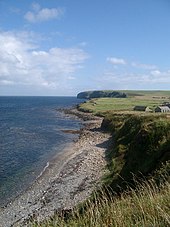
In 1991, the island's peaceful life was rocked when police and social workers swooped on island homes and seized nine children by force from their families. The parents were accused of child abuse and satanic rituals and the case became national news for weeks. Eventually the case was thrown out of court when it was found the social workers were using unorthodox interrogation techniques to force confessions and convince themselves of the truth of the allegations, though the children all denied any abuse.[11]
There are many well-preserved houses and other structures in the local vernacular style.
Natural history
The vole Microtus arvalis ronaldshaiensis is one of five varieties of Orkney vole, a sub-species of the common vole found only in the Orkney islands. Larger than the common vole, it resembles the field vole but has shorter, paler fur.
The Orkney voles were introduced to the archipelago in Neolithic times. The oldest known radiocarbon-dated fossil of the Orkney vole is of 4,600 years ago.[12]
References
- Notes
- ↑ 1.0 1.1 1.2 Wenham, Sheena "The South Isles" in Omand (2003) p. 212.
- ↑ 2.0 2.1 Wenham, Sheena "The South Isles" in Omand (2003) p. 211.
- ↑ "Orkney Placenames - natural elements" Orkneyjar. Retrieved 15 July 2007.
- ↑ Hedges, J. 1990. Tomb of the Eagles: Death and Life in a Stone Age Tribe. New Amsterdam Books. ISBN 0-941533-05-0
- ↑ "Isbister (Tomb of the Eagles) Chambered Cairn" Stonepages.com. Retrieved 16 November 2008.
- ↑ "Liddle Burnt Mound" Stonepages.com. Retrieved 16 November 2008.
- ↑ 7.0 7.1 7.2 "ORKNEY: O4. Paplay, South Ronaldsay" The Papar Project: RCAHMS. Retrieved 16 November 2008.
- ↑ Wallace, J. (1693) A Description of the Isles of Orkney by Master James Wallace, published after his death by his son, to which is added, An essay concerning the Thule of the ancients (by Sir Robert Sibbald). Edinburgh. John Reid. Quoted by The Papar Project RCAHMS. Retrieved 16 November 2008.
- ↑ Wenham, Sheena "Modern Times" in Omand (2003) p. 103.
- ↑ Wenham, Sheena "The South Isles" in Omand (2003) pp. 212–13.
- ↑ "Orkney 'abuse' children go home". BBC On this Day (April 4, 1991). 4 April 1991. http://news.bbc.co.uk/onthisday/hi/dates/stories/april/4/newsid_2521000/2521067.stm. Retrieved 2007-07-13.
- ↑ S. Haynes, M. Jaarola & J. B. Searle (2003). "Phylogeography of the common vole (Microtus arvalis) with particular emphasis on the colonization of the Orkney archipelago" (abstract page). Molecular Ecology 12: 951–956. doi:10.1046/j.1365-294X.2003.01795.x. PMID 12753214. http://www.blackwell-synergy.com/doi/abs/10.1046/j.1365-294X.2003.01795.x. "no".
Books
- Haswell-Smith, Hamish, The Scottish Islands (2004) ISBN 1-84195-454-3, Canongate
- Hedges, J. 1990. Tomb of the Eagles: Death and Life in a Stone Age Tribe. New Amsterdam Books. ISBN 0-941533-05-0
- Omand, Donald (ed.) (2003) The Orkney Book. Edinburgh. Birlinn. ISBN 1-84158-254-9
- Anderson, Joseph (Ed.) (1893) Orkneyinga Saga. Translated by Jón A. Hjaltalin & Gilbert Goudie. Edinburgh. James Thin and Mercat Press (1990 reprint). ISBN 0-901824-25-9
Outside links
| Islands of Orkney |
|---|
|
Inhabited islands: |
